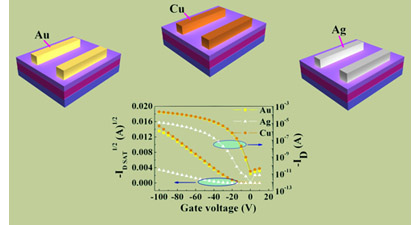Chong-an Di Gui Yu* Yunqi Liu* Yunlong Guo Ying Wang Weiping Wu and Daoben Zhu
Organic field-effect transistors (OFETs) have attracted considerable attention over the last few decades because of their potential applications in integrated circuits for large-area flexible and ultra-low-cost electronics such as radiofrequency identification tags and organic active matrix displays. In recent years tremendous progress has been achieved in both the design of organic semiconductors as well as device fabrication techniques.
For p-type OFETs Au has been the most frequently used S–D electrode material. Unfortunately the high cost of Au limits its use in real-world applications. Here we have discovered that OFETs based on several organic semiconductors with Cu top-contact (TC) S–D electrodes exhibit excellent field-effect properties. Notably efficient hole injection has been achieved by engineering good contact between the electrodes and the organic layer as well as by the oxidation of Cu during the vacuum deposition process or upon subsequent exposure to the ambient atmosphere. This approach affords a simple and efficacious route to realize high performance low-cost OFETs without the need for any additional modifications. Therefore the integration of Cu which is widely used in the inorganic silicon industry as the S–D electrode material will further advance the development of OFETs.
Adv. Mater. 2008 20 1286–1290

Figure 1. Schematic diagram of field-effect transistors with different metals as electrodes and their output characteristics. , |
